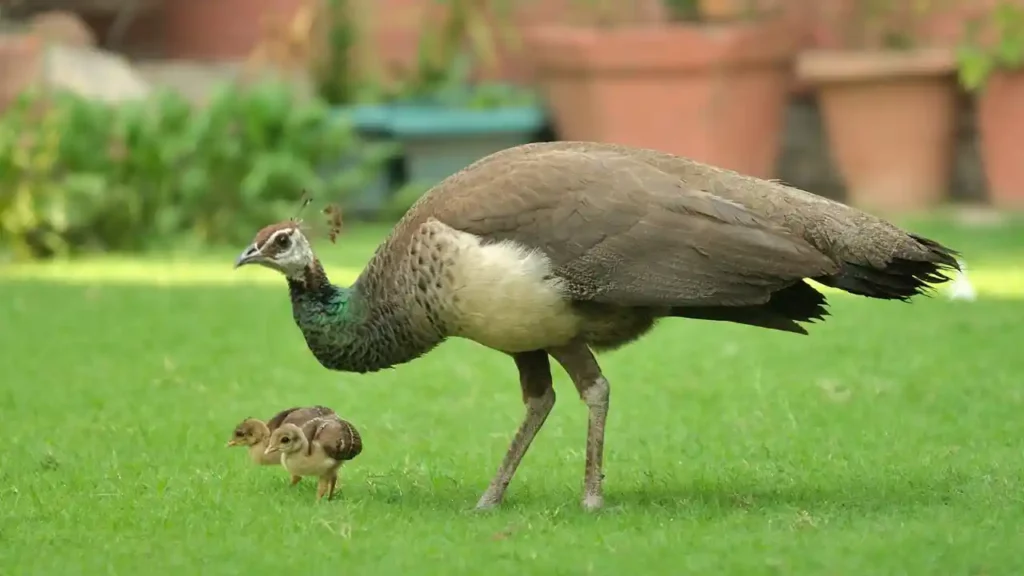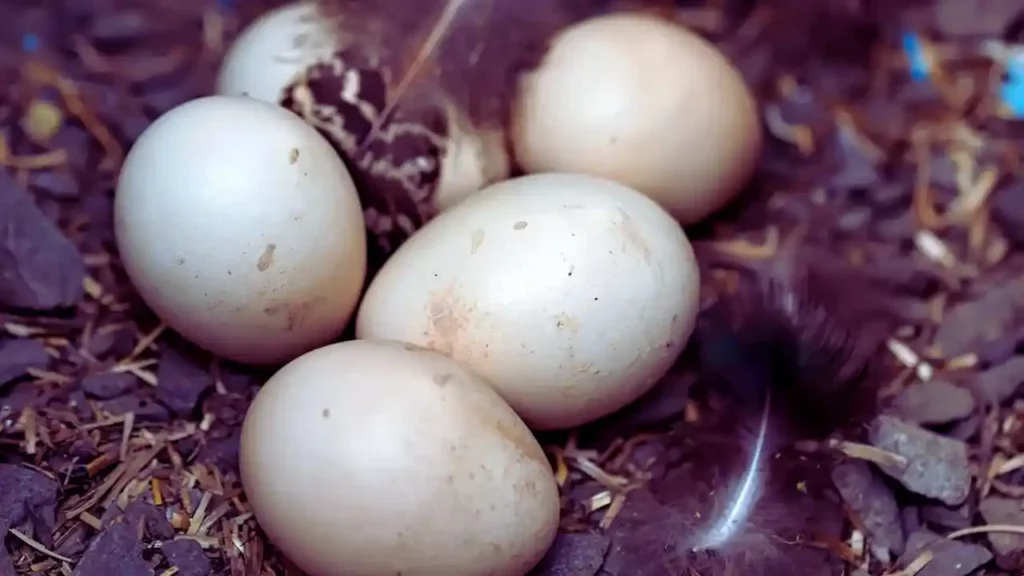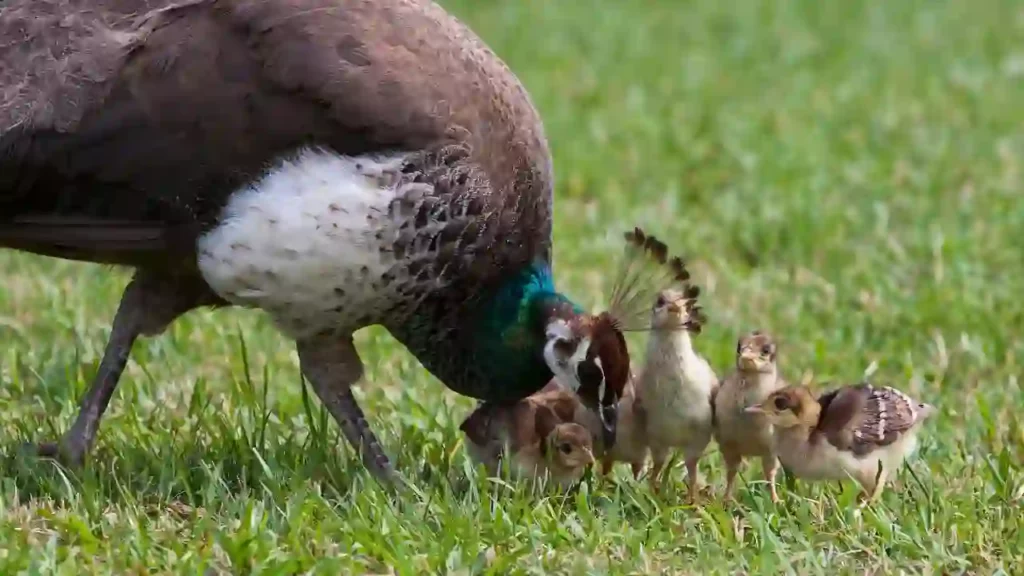Peacocks are distinguished by their enormous tail and brilliant colours. Two out of the three species are found in Asia. Peacocks were formerly imported to Egypt by the Phoenicians for ornamental purposes.
Baby peacocks are also called peahens or peachicks. They have some of the most complex feathers on the planet when they grow into adults. Peacock eggs require 28–30 days to hatch. A peahen can lay two to three clutches each season. Peacocks live for 20 years and begin to develop their plumage at approximately 2 years old.
Let’s develop trivia about baby peacocks and learn more about them in this article:
What Does A Baby Peacock Look Like?

The peacock babies resemble a hybrid between an adult peacock and a pheasant chick because of their striped wings, which mimic those of a juvenile pheasant.
With time, they gain adulthood and the peachicks’ hidden feathers on their throat, chest, head, and tail begin to become greenish with iridescence, changing from brown to black and they acquire the typical peacock appearance.
As they age, their colours become more vibrant, with blue out of the brilliant shades peaking in the late summer through winter and red peaking during in the spring time when peacocks are the happiest.
What Color Are Baby Peachicks?
The male peafowl is known as a peacock, while the female is called a peahen, and the young are referred to as peachicks.
Adult female peafowls have gray and/or brown plumage.
The Peacock chicks can display a range of colors, from yellow to tawny, with darker brown patches or light tan and ivory hues, sometimes described as dirty white. Peacocks are known for their extravagant plumage and color-changing tail feathers.
The peacock’s signature feature is its elongated, train of colorful feathers that it fans out during courtship displays.
The vibrant colors of the peacock’s feathers have made them popular among artists and fashion designers, inspiring creations throughout history.
How Big Is A Baby Peacock?

Baby peacocks (peafowl) vary in size depending on the species. As we know, there are three species of peacocks; the Indian Peacock, the blue Javan peacock and the Congo Peacock.
The Indian peafowl (Pavo cristatus) is the biggest of the three when fully grown, with males reaching lengths of up to 16 inches and weight of up to 10 pounds.
Although females are typically much smaller than males of the same species, they may nevertheless reach lengths of over 11 inches and weights of up to five pounds.
How Much Do Baby Peacocks Weigh?
When peachicks are born immediately, they weigh somewhere around 103g.
In comparison to other birds, peachicks weigh a lot—approximately five times heavier than a typical pheasant chick, which weighs around 20g and is almost twice as heavy as a duckling (baby duck).
It’s easy to raise peachicks in a farm but when the peacocks reach adulthood and grow their full-fledged trail and become enormously large, they should be released back into the wild because they are wild creatures.
What Is A Baby Peacock Called?

Peafowl’s babies are called peachicks.
Peacocks is a collective term used to describe the bird in question, regardless of sex; Peacock is the name given to the male one, and peahen to the female one.
Peachicks often have caramel and yellow colouring with areas of dark brown or lighter tan.
Peacocks come in three prominent varieties: the blue peacock, which is found in India and Sri Lanka, and the green peacock, which is found in Java and Myanmar and then there is Congo peacock which was identified off late.
What Do Juvenile Peacocks Look Like?
Peachicks have patterned fluffy feathers that imitate those of a baby pheasant, to whom peafowl are highly related, and are covered in light brown fluff fleece.
It takes a young peacock a few months to develop its train of tail feathers, male peachicks have longer legs than females do.
Additionally, they will have slightly darker breast feathers than that of the remainder of the flock.
What Is A Group Of Baby Peacocks Called?
There is no particular term ascribed to call baby peacocks by but peacocks have a whole catalogue of names for their groups.
These include ostentation, pride and muster. When peacocks grow and turn into adults, their groups are addressed by the mentioned names.
Do Baby Peacocks Need a Heat Lamp?
Baby peacocks require a heat lamp as they do not yet possess feathers and are susceptible to cold temperatures.
When a baby peacock hatches, it is typically covered in downy feathers and remains in a nest. It must remain in the nest until it grows feathers. If the baby peacock’s nest becomes too cold, it will impede feather development and could lead to its demise.
The heat lamp should be kept approximately two feet from the nest and provide a temperature of 90-95°F during the day.
When the baby peacocks reach 8 weeks old, their feathers will have fully developed. At this time, they can safely move outside into a fenced-in area where temperatures are monitored and protected from predators.
What Do Baby Peacocks Eat?
Peachicks are undemanding and non-discriminating omnivores. They enjoy a diverse and adaptable diet that comprises both plant foods and several types of meats.
Like adult peafowl, peachicks too require a high-protein diet, especially for the development of their feathers.
Whenever peachicks are raised in captivity, high-protein bird mixes are usually fed to them. Apart from that, they also feed on a variety of berries, vegetables, grains, meat, bugs, and mealworms.
What Do Peacock Eggs Look Like?

The majority of the time, peacock eggs are oof-white or milky white in hue. Peacock eggs, nonetheless, can also be found in shades like blush pink, greenish yellow, pale yellow, or reddish-brown.
When combined with eggs from other poultry, peacock eggs are often bigger and simpler to spot.
Given their similar appearance, chicken, duck, and goose eggs might not fall within this category. Peacock eggs have a thicker eggshell than chicken eggs do.
As a result, to spot a peacock egg, seek for one whose eggshell is challenging to crack.
How Many Eggs Do Peacocks Lay?
A peahen can lay 3 to 5 eggs at a time and she can yield two or three clutches throughout the season that means it can lay around 10 to 15 eggs per season.
The Peahen will carry on laying if the eggs are taken out every day. The Peahen will seem sagging on days when she is going to deposit an egg.
Her feathers will be slanted downward, and they will often have puffy feathers. The Peahen walk away after dropping the egg to the ground.
How Long Do Peacock Eggs Take To Hatch?
A peacock egg typically takes two months to mature. After that, it normally takes a week for the eggs to hatch.
For those peacock eggs which hatch in captivity, egg cups are specialized incubators.
To allow heat and moisture to penetrate the egg, it features a little aperture at the top. Peacocks generally incubate for about 27 to 30 days, which is typical for birds.
If you are raising them in your farm, a wooden or plastic nest box should be used to house the egg cup. The nest box has to be kept in a place that is shielded from precipitation, ice, and freezing temperatures.
When Do Peacocks Lay Eggs?
Early spring marks the beginning of peacocks’ mating season, which lasts into late summer.
Although it happens more frequently in the summer, peahens can deposit their eggs at any moment throughout this season.
A peahen may produce a clutch of eggs twice to three times every year, depending on how many eggs you opt to remove so they cannot hatch.
How Do Peacocks Feed Their Chicks?

Peachicks will often consume many of the same items as their mother in the wild, but in smaller, more manageable chunks.
Peachicks may do without nourishment for the first 24-48 hours after hatching. Since they have been ingesting nutrients from the yolk sack
For the first several days, the mother peahen will feed her peachicks little amounts of food while keeping a watchful eye on them.
Peachicks will often begin foraging, scrounging about, and determining what they can and cannot consume on their own in 3–4 days.
How Do Baby Peacocks Learn To Hunt And Forage?
A new born peacock can begin foraging on its own in 3 to 4 days. However, occasionally it could take two to four weeks. Young peacocks develop quickly, so it doesn’t take long for them to reach their full potential.
When baby peacocks first start foraging on their own, they seek their mother’s advice to determine what is and is not edible.
During the first several weeks or months, peachicks closely observe their mothers’ foraging and hunting techniques.
They look for softer foods at this early time. However, after two to four weeks, their beaks grow strong and sharp enough to hunt for different meals.
They then begin eating or attempting to eat frogs, snails, slugs, lizards, insects and other creatures at this time.
When Can Baby Peacocks Fly?
Peachicks pick up flying rather quickly; many fly for the first time between one and two weeks after being born.
In order to prevent harm to the young, the mother typically stimulates the peachicks to take flight throughout the night, frequently from a location that is not excessively high above the ground.
Most peachicks begin to fly after the eighth week. Typically, they only fly a relatively short distance.
When Do Baby Peacocks Leave Their Nests?
Around the age of twelve weeks, peachicks usually take their first flight. When fully mature, peacocks have the ability to soar to heights of around 15 feet and glide back down.
When pressed for time, peacocks have a top speed of 50 kilometres per hour (35 miles per hour).
Peafowl typically live for around twenty years, however they frequently pass away earlier due to predation by animals like leopards, pythons, and eagles.
Do Peacocks Reuse Nests?
Peahens also occasionally take over abandoned nests or add to ones that already exist, resulting in bigger and heavier nests than those made by the males alone.
Female peafowl have been recorded making their own nests without any assistance when there are no male peacocks present during the mating season.
How Long Do Baby Peacocks Stay With Their Parents?
For almost four months since their birth, young peacocks remain with their parents. The infants will consume their nutrition through their parents throughout this period.
The parents instruct the infants in flying when the time comes as the infants require some time to figure out how to fly.
During the first few weeks following they begin to separate from their parents, peachicks probably stay in close proximity to her until they start to find their own partners and start to enlarge their area.
Once they find their mate, they are completely detached from their parents.
How Fast Do Baby Peacocks Grow?
Peachicks first grow in size and then feathers grow later. Male Peacocks reach maturity in around two years. The peacocks abandon their train after breeding season.
After that, feathers grow back every year. The lengthy feathers of a male peacock are not the tail feathers. Their rear feathers are seen as a lengthy train.
To develop the signature train that we associate with peacocks and reach full sexual maturity, peacocks may take up to 3 years of age.
Peacocks in the wild have a lifetime of around 20 years.
How Many Baby Peacocks Survive To Adulthood?
Peacocks lay very few eggs and even of the laid eggs, the majority gets damaged, so the percentage of eggs that get to hatch first are very low.
Out of the total eggs hatched , only about one-third of peachicks get to survive.
During their early days, peachicks are particularly vulnerable, with only about 33% of them surviving until adulthood. Predation and illness are the primary factors contributing to their mortality.
Peachicks need feed rich in protein for their overall development and failure in getting so results in them perishing.
Final Thoughts
Baby peacocks look like just any other pheasant chick when they are hatched. They later grow into their specific peacock look, developing the signature train and magnificent crest.
The baby bird rely on their parents, mother specifically for nourishment initially but they start the capability to hunt and forage pretty soon. They reach maturity at the age of 2 years and have a lifespan of around 20 years.


